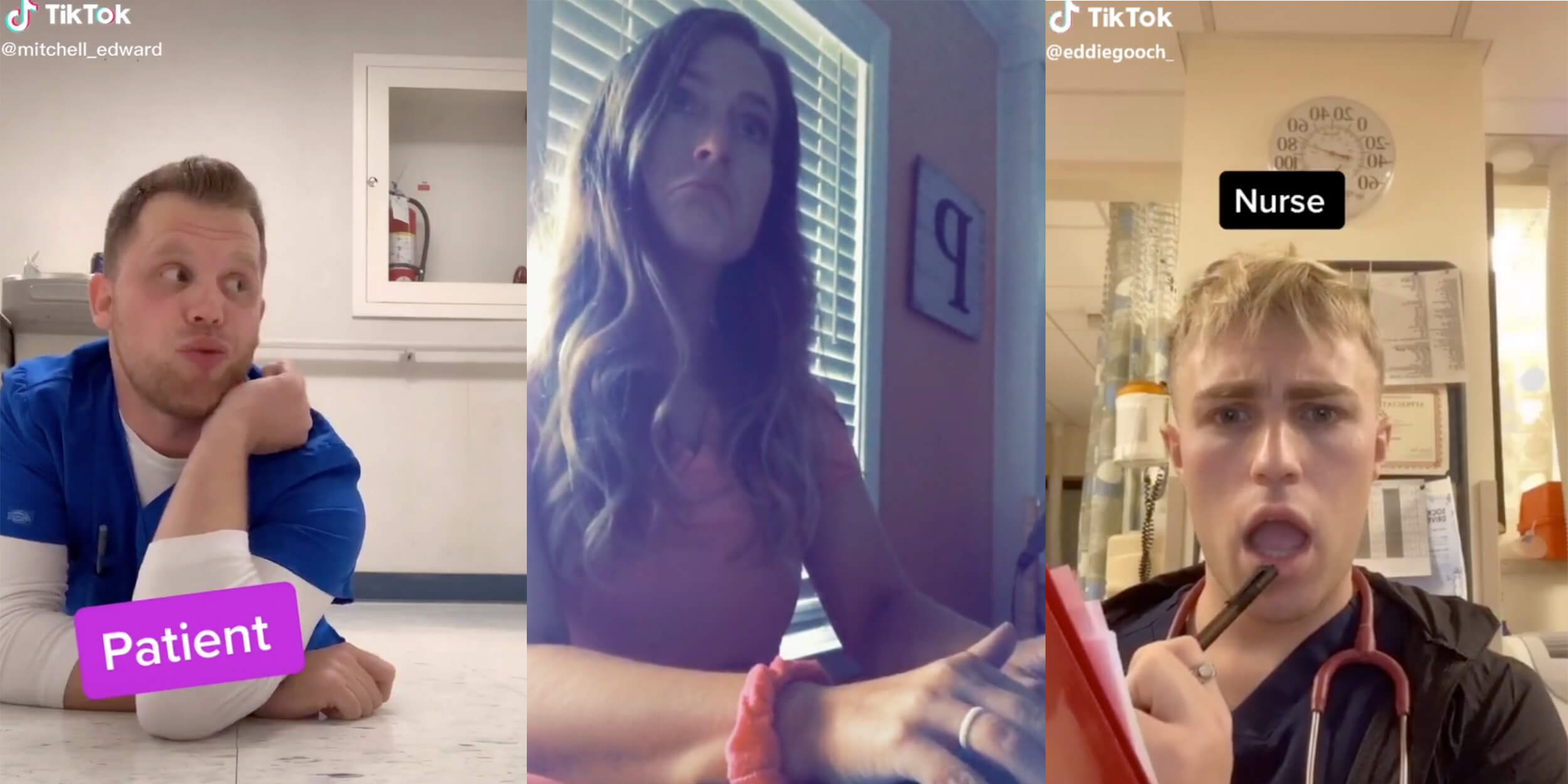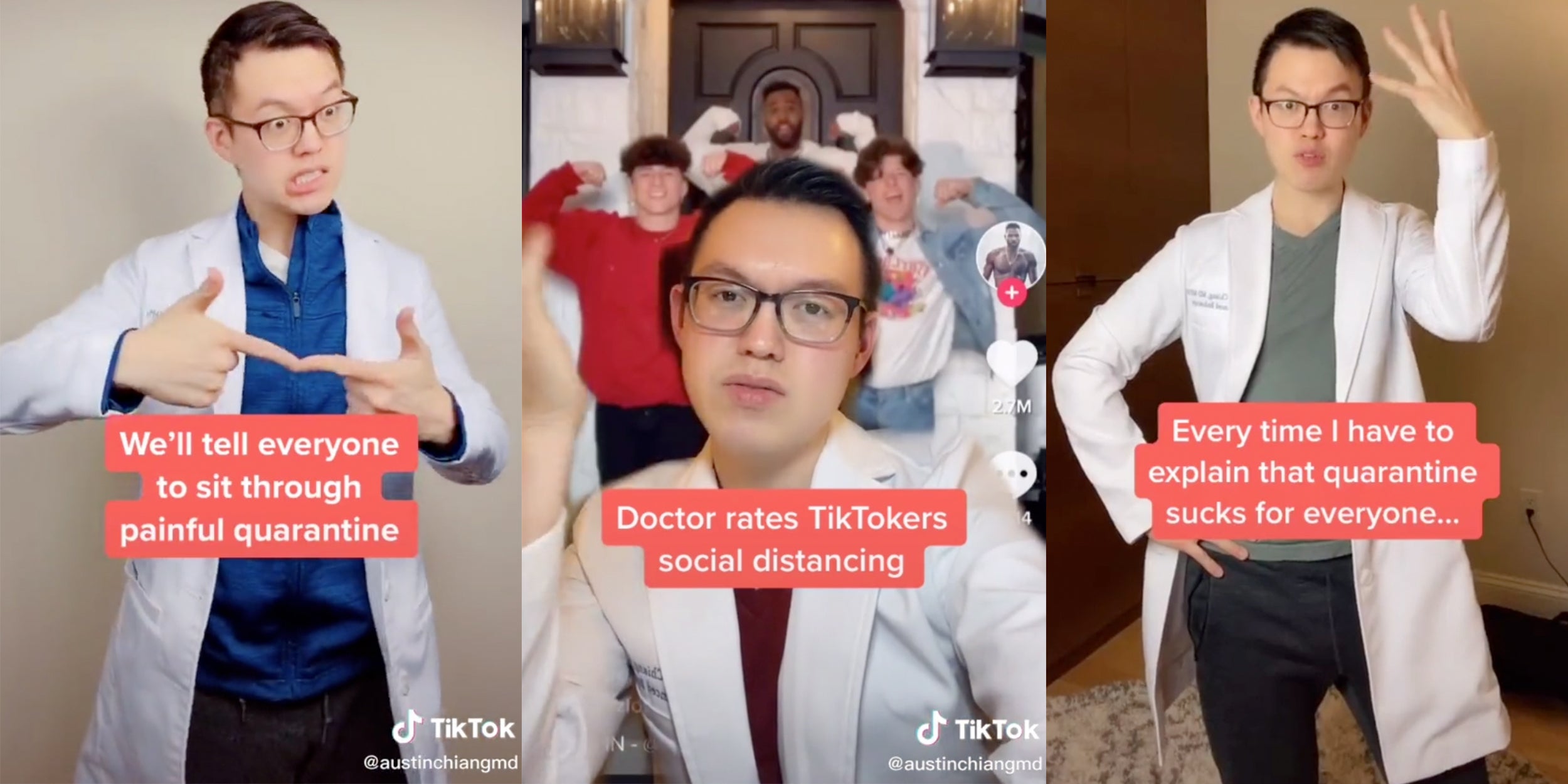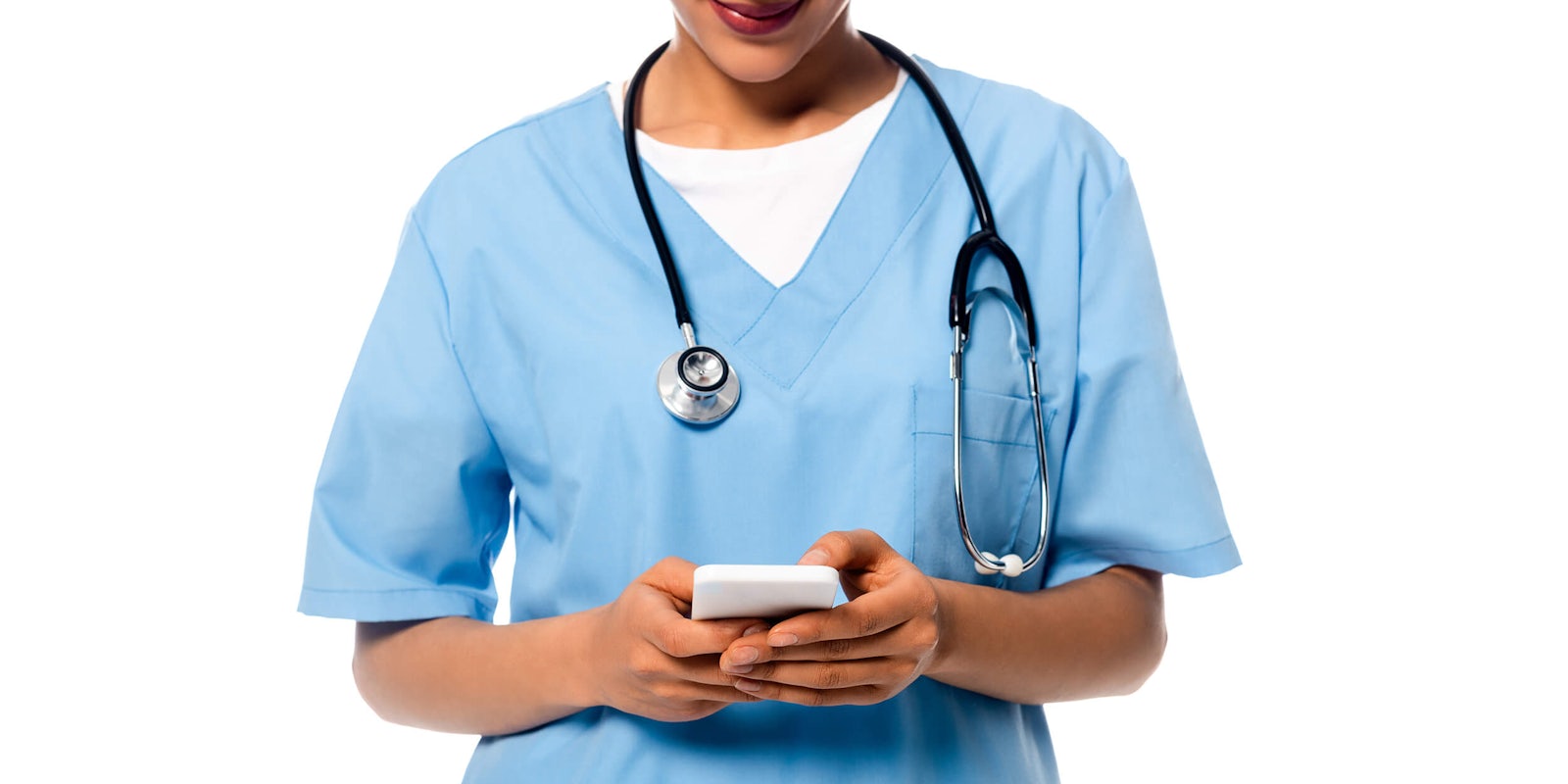In January, news outlets around the world published stories about the viral TikTok star “Nurse Holly” after she incorrectly claimed in one of her videos that abstinence was the best method to not contract sexually transmitted diseases. People stormed social media to criticize the nurse for sharing incorrect health information on TikTok, the popular video-sharing platform where more than half of users are between the ages of 16 and 24.
Following the backlash, Nurse Holly deleted the video and shut down her TikTok account. But the damage was already done. Articles like “TikTok’s Medical Professionals Maybe Aren’t All That Professional” and “If You’re a Nurse, Please Stop Embarrassing Your Entire Profession on TikTok” flooded the internet.
The central question behind the articles: Are healthcare professionals on TikTok helping or hurting?
At first glance, it seemed like medical professionals on TikTok were damaging the relationship between healthcare providers and patients. Still, despite the bad rap some of the TikTok stars have given the profession, healthcare professionals argue that doctors and nurses should be on the platform to help combat misinformation, to spread educational material about taboo topics, and to show young people that they are relatable and trustworthy.
Take the coronavirus pandemic, for example. Health professionals are explaining social distancing, telemedicine, how to properly wash your hands, or how the virus affects pregnancies. Although the videos riff off popular trends like the viral quarantine TikTok song, the information is accurate and informative.
Meanwhile, other videos show medical professionals pretending to be a COVID-19 patient or having a beer before work because nurses have to “[deal] with them fucking idiots all day.”
The coronavirus-related videos illustrate the range in how health professionals approach social media, but their use of TikTok hasn’t just materialized since the pandemic. It’s a problem the medical field has wrestled with over time.
Viral TikTok catastrophes
Healthcare professionals who have been criticized for being inappropriate on social media have made a much larger splash than the doctors and nurses who are doing it “correctly.” Nurse Holly is far from the only medical professional or trainee who made headlines for spreading misinformation.
There was also “D Rose,” whose TikTok video making fun of patients experiencing pain prompted the viral Twitter hashtag “#PatientsAreNotFaking.” Using this hashtag, people shared moments when they felt like their health concerns were dismissed. They pointed out that this can be deadly, especially for women of color who experience medical discrimination at higher rates. Then there was the nursing student who mocked patients who are sick and not eating. But those are high-profile cases of inappropriate behavior on TikTok.
A quick scroll through hashtags like #nurselife and #nurse on TikTok will inevitably pull up some questionable videos. There’s a video of a nurse pretending to curse and fight a patient. In the comment section, people claiming to work in the healthcare field have left comments like, “I work at a psychiatric hospital and this is me daily!” There are also videos of health professionals mocking patients on suicide watch, judging people’s sex lives, and making fun of patients’ drug use.

One video shows a hospital staffer pretending to be a patient who says she has “drugs in my booty.” Then as a nurse, he explains to the “patient” that this could cause an infection. The video ends with the “patient” retorting, “Girl, you can’t get no infection in your booty hole. It’s a booty hole.”
Misuse of social media is a widespread issue in the medical field. According to one study, 60% of surveyed medical schools reported their trainees had posted “discriminatory and sexually explicit content.”
However, the consequences for inappropriate content are still unclear, even to health professionals themselves. About 67% of those surveyed medical schools said they “informally” reprimanded the students, while only 7% dismissed the student. In the professional field, the Association for Healthcare Social Media, an organization dedicated to giving medical professionals advice about how to navigate social media, was advising the medical field as recently as January to adopt a “systematic manner” for disciplinary action.
“We believe that consequences from inappropriate social media behavior can serve as important lessons for health professionals as they proceed in medical practice and professional development,” the organization wrote.
Patient mistrust
Although the TikTok stars are often aiming to make “relatable” content for other medical professionals, the posts are public, and the videos making fun of patients are insensitive and fuel distrust. The hashtag #PatientsAreNotFaking addresses just this. The hashtag, one disability activist tweeted, is “important because we discount our own bodies already; we don’t need [doctors and nurses] to do it too.”
People don’t want to get medical help if they think their nurse or doctor will hop on social media after the appointment and make a TikTok video mocking them. Plus, the TikToks can leave people wondering things like: Will my doctor believe me? Will my nurse judge me for my sexual choices?
Twitter users have shared thoughts and jokes about these types of TikToks.
“When the nurse leaves to get the doctor, she’s actually making a TikTok about how you’re a sinner,” Twitter user @mattbooshell wrote.
There are also memes about the dismissive behavior.
“Me, crawling on all fours into the emergency room: p-please help I’m––
TikTok nurse: You’re ugly, you’re disgusting, I’m gonna kill you, give me $200,” Twitter user @life_of_zahra tweeted along with a picture of Dr. Phil.
Vague guidelines
It seems like patients weren’t the only people bothered by some of the viral TikTok videos. Shortly after backlash over several viral nurses and doctors in January, TikTok updated its community guidelines. TikTok wrote that it does not permit misinformation and that it would remove “misinformation that could cause harm to an individual’s health or wider public safety.”
“Do not post misinformation that may cause harm to an individual’s health, such as misleading information about medical treatment,” the guidelines read.
The platform also launched a method for users to report videos and accounts if they feel like they’re posting misleading information. The content then goes to a special team that decides whether it breaches community guidelines.
However, it’s not TikTok’s responsibility to decide what’s offensive and what’s not. The platform can’t discriminate against posts based on someone’s profession. It only takes action when someone breaks its community guidelines. That’s for hospitals and health professionals to decide.
And healthcare professionals didn’t ignore the problem, either. In fact, the Association for Healthcare Social Media released a statement after the Nurse Holly uproar. The statement was directed at social media accounts that “perpetuate health misinformation” and “exacerbate distrust of health professionals.”
“Some health professionals and medical trainees have demonstrated activity and/or behavior on social media that may adversely affect public health and public opinion of the medical profession,” the statement reads.
The organization advocated for healthcare institutions to take disciplinary action against these types of accounts.
READ MORE:
- The delicate balance of disclosing mental illness on social media
- How to talk about disability issues on the internet
- Who is #BodyPositivity for? It depends who you ask
- Social media sites are ditching their content moderators at the worst possible time
- Meet the Wikipedia editors fighting to keep coronavirus pages accurate
Should nurses and doctors be on TikTok?
Austin Chiang, the president of the social media association and an assistant professor of medicine at Thomas Jefferson University Hospitals, said that there are a ton of medical professionals posting accurate and helpful information on social media. Those medical professionals, he said, show that social media platforms—including TikTok—are positive tools for connecting with patients.
TikTok has often been singled out as a platform that healthcare professionals should avoid. But Chiang, who has a TikTok himself and in recent videos has given quarantine advice while dancing, says there’s no reason to stay off the platform. Health providers just need to know their boundaries.
“There is still a lot of criticism about health professionals being on TikTok, but I think if you use it in a way that’s respectful and engaging and interesting, then it’s no different than other social media platforms,” Chiang said.

Even more, Chiang said that he recommends that healthcare professionals with the right tools and messaging use TikTok because they’re able to serve a “whole different section of the population.” He’s talking about the average TikTok user—a young person who might not follow health professionals on Instagram, YouTube, or Twitter.
“If we’re not on these platforms, and other people are, other people who don’t necessarily have the appropriate training, then that’s how misinformation is spread,” Chiang said. “We may be further distancing ourselves from patients by not using [TikTok].”
People are looking for medical information
Chiang has a point. It’s estimated that about 80% of internet users search for health information online, 74% of those on social media, according to the National Institute of Health. And if medical professionals aren’t on social media platforms, especially those like TikTok which serve a younger audience, who will be answering their health questions? Likely people who are untrained to do so.
That’s where doctors, like gynecologist Staci Tanouye, come in. She started on Instagram but then realized that TikTok had the audience she was looking for. They are young and engaged. It’s estimated that an average TikTok user uses the app for about an hour every day.
“As a gynecologist who teaches women’s health and wants women and young women to learn more about their bodies, I felt that it was kind of the perfect avenue to try to get my message out to the younger generation,” Tanouye told the Daily Dot.
On TikTok, she said, she tries to share messages about sexual health, women’s health, women empowerment, and body positivity to young folks.
Providing early, comprehensive sex and anatomical education has been proven to be beneficial for teens. It pushes back the age that teens start having sex, decreases sexually transmitted diseases, lowers teen-pregnancy rates, and gives teens a more positive outlook on their bodies, she said.
In her videos, Tanouye often manipulates TikTok trends, like the viral dance to Doja Cat’s song “Candy,” so that they can apply to sex education topics. In her viral “Candy” video, she participated in the TikTok dance challenge, using it to describe how herpes can be spread to genitals during oral sex.

This kind of information is crucial because teens often aren’t getting it from school or their communities, she said. The doctor has received thousands of comments and messages from teens, both women and men, thanking her for her content.
“Some of those messages are a little heartbreaking. Some of them are saying, ‘I’m learning more from your TikToks than I do in school.’ Or, ‘I’m in sixth, seventh, or eighth grade, and I’ve never heard or learned about this before,’” Tanouye said. “It’s very apparent that this information is not only necessary but also wanted by this audience.”
But the feedback hasn’t all been positive. There are people who disagree with doctors touching certain health topics on social media, such as sex education or vaccines. In addition, there are some who think that it’s unprofessional for healthcare professionals to dance, follow viral trends, or include explicit music in their videos.
Healthcare influencers
To complicate things even more, there are a number of TikTok nurses and doctors who, unlike Tanouye, aren’t trying to educate. They’re using TikTok for self expression or as a side hustle—and they’re just trying to give people a good laugh.
The American Nurses Association seems to understand that nurses are creating their accounts to advance their career through entertainment. (The association did not respond to requests for comment by the time of publication.)
“[Social media] can not only be entertaining and informative, but it also has the potential to help your career as a nurse and the nursing profession in general,” the organization writes in its social media guidelines.
One of the nurses using social media for entertainment is Andrew Rattay. He discovered TikTok about a year ago. Rattay was in his house listening to his girlfriend and her friend bursting into laughter every couple of minutes. It turned out that they were sending each other TikToks.
He had been looking for a platform to provide entertainment for and inspire other nurses. Rattay also wanted to become a healthcare influencer, someone who promotes healthy lifestyles and health products.
“I realized TikTok is a great way to rapid-fire post videos and share videos. The entrepreneur in me was like ‘Man, this is a great opportunity,’” Rattay said.
In about three months, the nurse had 27,000 followers. Now, he has about 63,000 followers. In his videos, he tends to post comical videos about the “nursing life.” Rattay doesn’t usually create videos spreading health information and tries to stay away from making videos about interactions with patients.
Although he said he’s had overwhelmingly positive feedback, he said he’s seen a couple of comments that videos like his are unprofessional. But those criticisms don’t deter him. At one point, he said, Twitter was thought to be unprofessional.
“I think it’s kind of silly. I think there will always be the naysayers when people start doing something new,” Rattay said. “Twitter was once like that, but now Twitter is just full of doctors that post content. I feel like the doctors who are on [TikTok], who are posting good content and accurate content, are kind of fighting the good fight.”
Instead of finding TikTok videos unprofessional, Rattay thinks that fun, entertaining videos—when accurate and respectful—can actually help the patient-provider relationship.
“At the end of the day, you want your nurse to be someone that is fun, someone who is relatable, someone who is passionate, so I try to showcase that in my TikToks,” he said.
Controlling the problem
Rattay, who’s been a nurse for about a year, said he’s “learning as he goes” when it comes to social media.
Maybe that’s where the room for error comes in: There’s a lack of social media education for healthcare professionals. Although social media was discussed during Rattay’s nursing school, the instructions didn’t veer far from the idea that nurses need to protect patient privacy.
But as for how to create entertaining content and how to connect with patients online, there wasn’t much guidance.
Often, medical professionals have been left with the understanding that it’s important to use social media, but they haven’t been given training on how to correctly and appropriately connect with their audience.
But that’s necessary, because when done correctly, medical professionals can use social media as a great tool for spreading accurate medical information, reaching the younger generation about crucial topics, and generating confidence in health professionals. It’s even more vital amid coronavirus, a global health pandemic that has killed more than 1,000 people in the U.S. and led to more than 500,000 cases worldwide.
“Times are changing, and we have to go where our patients are, and we have to go where people are getting their information,” Tanouye said.
